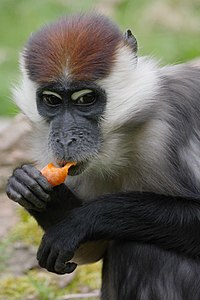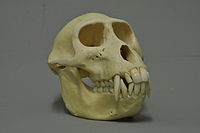Collar specification
| Collar specification | ||||||||||||
|---|---|---|---|---|---|---|---|---|---|---|---|---|

Collar indication ( Cercocebus torquatus ) |
||||||||||||
| Systematics | ||||||||||||
|
||||||||||||
| Scientific name | ||||||||||||
| Cercocebus torquatus | ||||||||||||
| ( Kerr , 1792) |
The collar indication , also called red head or red head indication ( Cercocebus torquatus ), is a species of primate from the family of vervet monkeys (Cercopithecidae).
features
Collar sizes have a slim build and a relatively long tail. They are similar in physique to monkeys , but are larger. They reach a head body length of 45 to 67 centimeters, the tail is about as long. At 7 to 12.5 kilograms, males are significantly heavier than females, which can reach 5 to 8 kilograms. Their fur is gray on the upper side, the belly is whitish.
The top of the head is reddish in color. The cheek hairs are whitish, this whiteness can extend to the nape of the neck. The face is black, the eyelids are white, as in all members of the genus.
distribution and habitat
Collar indications are native to central Africa , their distribution area extends from western Nigeria to Gabon . Their habitat are swamp forests and other forests near rivers and lakes, which can also be seasonally flooded.
Lifestyle and diet
These animals are diurnal and can be found both on the ground and in the trees. Foraging for food takes place on the ground or in the lower layers of the trees, they often climb further up the trees to sleep. They live in groups of 10 to 35 animals, they are multi-male groups that include several males as well as numerous females and their offspring. Both sexes develop a hierarchy that comes into play in, among other things, mating privileges and access to food sources. The animals communicate with postures, facial expressions and loud screams, with which they keep their own group together and make other groups aware of their own territory.
Collars are omnivores , but they mainly eat fruits and nuts. They eat seeds, leaves and other parts of plants just like insects and other small animals.
Reproduction
There is no fixed mating season. After a gestation period of around 170 days, the female usually gives birth to a single young. These reach sexual maturity at the age of five to seven.
threat
The main threats to the collars are the destruction of the habitat and hunting for their meat ( bushmeat ). Sometimes they are also persecuted because they invade and devastate plantations. The IUCN lists the species as "endangered" ( vulnerable ).
Systematics
The collar indication is one of six types into which the genus of the white-eyed mangaben ( Cercocebus ) is divided. As far as we know today, the Schwarzm indications are not closely related to them. The soot indication from West Africa used to be considered a subspecies of the collar indication, today it is mostly classified as a separate species.
literature
- Thomas Geissmann : Comparative Primatology. Springer, Berlin et al. 2003, ISBN 3-540-43645-6 .
- Don E. Wilson , DeeAnn M. Reeder (Eds.): Mammal Species of the World . A taxonomic and geographic Reference. 2 volumes. Johns Hopkins University Press, Baltimore MD 2005, ISBN 0-8018-8221-4 .
Web links
- Cercocebus torquatus in the endangered Red List species the IUCN 2011. Posted by: J. F. Oates, S. Gippoliti, C. P. Groves, 2008. Accessed July 30, 2011th
- Information at Animal Diversity Web (English)
- Photos and information on arkive.org (English)



